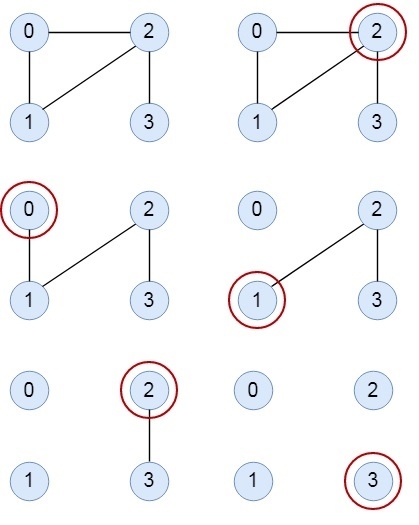
 Data Structure
Data Structure Networking
Networking RDBMS
RDBMS Operating System
Operating System Java
Java MS Excel
MS Excel iOS
iOS HTML
HTML CSS
CSS Android
Android Python
Python C Programming
C Programming C++
C++ C#
C# MongoDB
MongoDB MySQL
MySQL Javascript
Javascript PHP
PHP
- Selected Reading
- UPSC IAS Exams Notes
- Developer's Best Practices
- Questions and Answers
- Effective Resume Writing
- HR Interview Questions
- Computer Glossary
- Who is Who
Fleury’s Algorithm for printing Eulerian Path or Circuit in C++
Fleury’s Algorithm is used to display the Euler path or Euler circuit from a given graph. In this algorithm, starting from one edge, it tries to move other adjacent vertices by removing the previous vertices. Using this trick, the graph becomes simpler in each step to find the Euler path or circuit.

We have to check some rules to get the path or circuit −
- The graph must be a Euler Graph.
- When there are two edges, one is bridge, another one is non-bridge, we have to choose non-bridge at first.s
Choosing of starting vertex is also tricky, we cannot use any vertex as starting vertex, if the graph has no odd degree vertices, we can choose any vertex as start point, otherwise when one vertex has odd degree, we have to choose that one first.
Input − Adjacency matrix of a graph
| 0 | 1 | 1 | 1 | 1 |
| 1 | 0 | 1 | 1 | 1 |
| 1 | 1 | 0 | 1 | 1 |
| 1 | 1 | 1 | 0 | 1 |
| 1 | 1 | 1 | 1 | 0 |
Output − Euler Path or Circuit: 1--0 0--2 2--1 1--3 3--0 0--4 4--3 3—2
Algorithm
findStartVert(graph) Input: The given graph. Output: Find the starting vertex to start algorithm. Begin for all vertex i, in the graph, do deg := 0 for all vertex j, which are adjacent with i, do deg := deg + 1 done if deg is odd, then return i done when all degree is even return 0 End isBridge(u, v) Input: The start and end node. Output: True when u and v are forming a bridge. Begin deg := 0 for all vertex i which are adjacent with v, do deg := deg + 1 done if deg > 1, then return false return true End fleuryAlgorithm(start) Input: The starting vertex. Output: Display the Euler path or circuit. Begin edge := get the number of edges in the graph //it will not initialize in next recursion call for all vertex v, which are adjacent with start, do if edge <= 1 OR isBridge(start, v) is false, then display path from start and v remove edge (start,v) from the graph decrease edge by 1 fleuryAlgorithm(v) done End
Example
#include<iostream>
#include<vector>
#define NODE 5
using namespace std;
int graph[NODE][NODE] = {{0, 1, 1, 1, 1},
{1, 0, 1, 1, 0},
{1, 1, 0, 1, 0},
{1, 1, 1, 0, 1},
{1, 0, 0, 1, 0}
};
int tempGraph[NODE][NODE];
int findStartVert(){
for(int i = 0; i<NODE; i++){
int deg = 0;
for(int j = 0; j<NODE; j++){
if(tempGraph[i][j])
deg++; //increase degree, when connected edge found
}
if(deg % 2 != 0) //when degree of vertices are odd
return i; //i is node with odd degree
}
return 0; //when all vertices have even degree, start from 0
}
bool isBridge(int u, int v){
int deg = 0;
for(int i = 0; i<NODE; i++)
if(tempGraph[v][i])
deg++;
if(deg>1){
return false; //the edge is not forming bridge
}
return true; //edge forming a bridge
}
int edgeCount(){
int count = 0;
for(int i = 0; i<NODE; i++)
for(int j = i; j<NODE; j++)
if(tempGraph[i][j])
count++;
return count; //count nunber of edges in the graph
}
void fleuryAlgorithm(int start){
static int edge = edgeCount();
for(int v = 0; v<NODE; v++){
if(tempGraph[start][v]){ //when (u,v) edge is presnt and not forming bridge
if(edge <= 1 || !isBridge(start, v)){
cout << start << "--" << v << " ";
tempGraph[start][v] = tempGraph[v][start] = 0; //remove edge from graph
edge--; //reduce edge
fleuryAlgorithm(v);
}
}
}
}
int main(){
for(int i = 0; i<NODE; i++) //copy main graph to tempGraph
for(int j = 0; j<NODE; j++)
tempGraph[i][j] = graph[i][j];
cout << "Euler Path Or Circuit: ";
fleuryAlgorithm(findStartVert());
}
Output
Euler Path Or Circuit: 1--0 0--2 2--1 1--3 3--0 0--4 4--3 3—2

Advertisements
